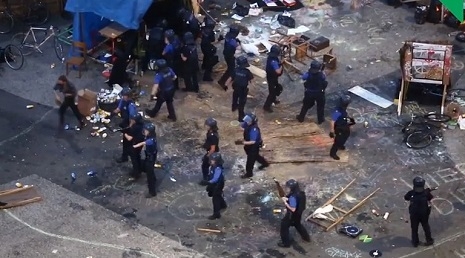
Occupy Wall Street catches a lot of criticism for failing to develop a tangible political trajectory in the United States. In fact, despite being the site of the original occupation, other countries appear to have benefited more from the movement. Spain, for example, still has a cohesive anti-austerity movement, and the Quebec student activists won a tuition freeze last May. The core idea though, of claiming a space for the public, seems to be the most resilient concept, and Switzerland’s riot last Friday is the latest installment. Events leading up to the incident are slightly complicated, but here goes…
Japanese artist Tadashi Kawamata and Swiss architect Christophe Scheidegger recently collaborated on an installation piece inspired by favelas, the shantytowns of Brazil that nearly 30% of Rio de Janeiro’s population calls home. Favelas aren’t exactly comparable to US ghettos, because though they exist in the midst of urbanity, they tend to lack any real infrastructure like running water or electricity. Kawamata and Scheidegger thought this was a cute concept for a trendy bistro, and so they opened the “Favela Café.” I guess when you don’t have any creative ideas yourself, imitating the resourcefulness of poor people seems like a good substitute—the ultimate bourgeois art, really. Very “Derelicte.”
The installation was actually commissioned by Art Basel, a prestigious and expansive international art show, named for the Swiss town of Basel where it’s held. Earlier this year, protesters from “Basel wird besetzt” (Basel will be occupied) attempted to reclaim an empty building in the town square for a public cultural center, but the cops evicted them after a month.
The occupation of the “Favela Café,” a particularly loaded symbol considering the “ritzy poor” aesthetic of the concept, was their second attempt at reclamation for the commons. It seems they had permission to protest for a period of time, but when they exceeded the limit, the police came down on them in full force. It will be interesting to see what, if anything, comes of this, along with the “Turkish Spring” protests.
People all over the world are making basic demands (though often with larger political undertones), for space that supposedly already belongs to the public, only to be met met with brutal repression—I suspect we’ll see more occupations of this kind in the near future.
Via Artleaks